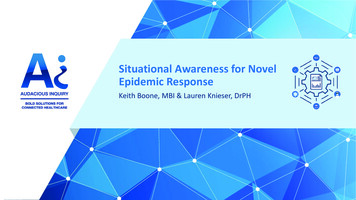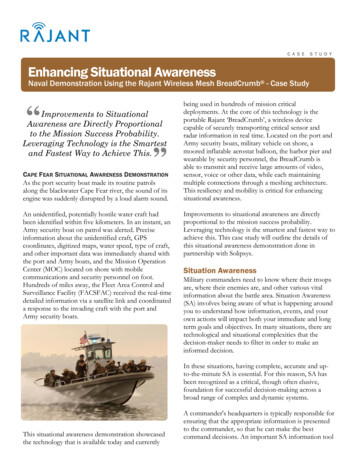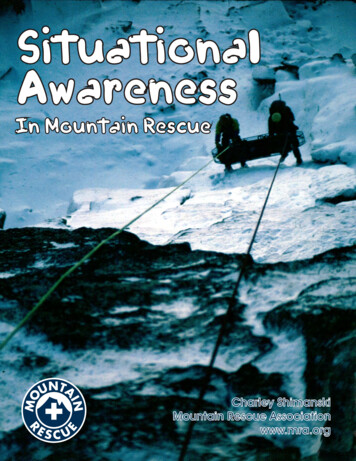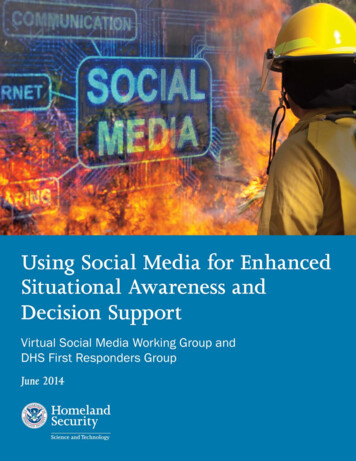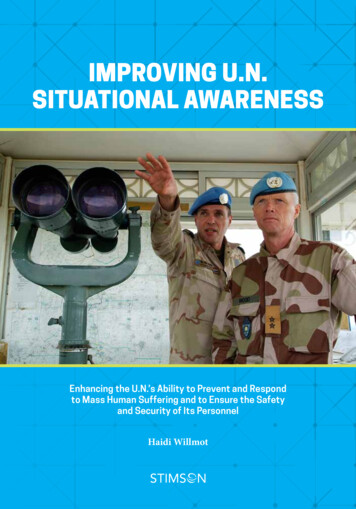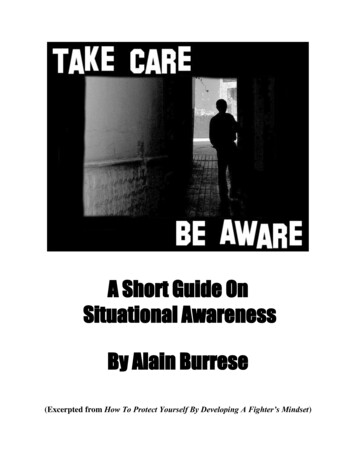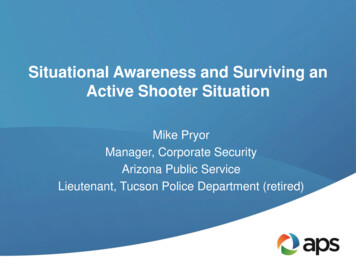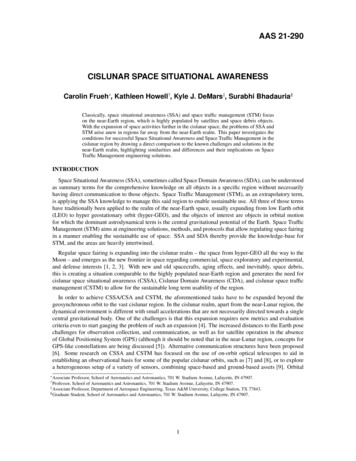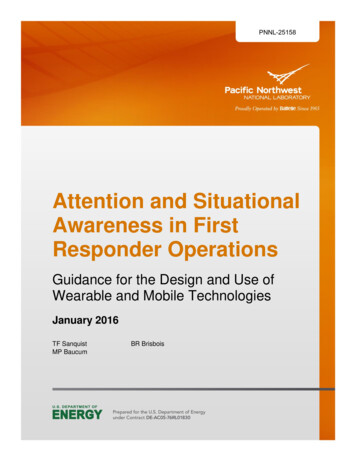
Transcription
PNNL-25158Attention and SituationalAwareness in FirstResponder OperationsGuidance for the Design and Use ofWearable and Mobile TechnologiesJanuary 2016TF SanquistMP BaucumBR Brisbois
PNNL-25158Attention and SituationalAwareness in First ResponderOperationsTF SanquistMP BaucumBR BrisboisJanuary 2016Prepared forthe U.S. Department of Energyunder Contract DE-AC05-76RL01830Pacific Northwest National LaboratoryRichland, Washington 99352
SummaryConcepts for Next Generation First Responders (NGFR) emphasize the capabilities of enhanced access tovarious kinds of information, whether through wearable technologies or other forms of display such asincident command common operating pictures. A critical issue in developing and deploying wearablesand other forms of data augmentation such as in-vehicle displays is the extent to which responders canmake use of additional information while performing their primary tasks effectively. Humans havelimited capacities for processing information, which are relatively fixed and will not change despite agreater availability of inputs. This report reviews research in the areas of attention and situationalawareness as it pertains to first responders’ safe and effective job performance.The research reviewed supports a human-centered view of situational awareness, based on the limitedcapacities of people for processing information, which is determined largely on the basis of what they payattention to at any particular moment. Attention can be consciously directed but also overridden byreflexive orienting mechanisms, referred to as hard-wiring. Thus, ever-increasing levels of data that arestreamed to people can have a beneficial impact in terms of speed and convenience of access, but also adetrimental impact on situational awareness. This is seen in social situations, driving, providing medicalcare, and even walking. First responders are subject to the same capacity limitations as civilian citizens –while they do develop strategies and experience for what to pay attention to and when, it is clear fromstudies of emergency response driving and accidents that distraction and performance degradation dooccur as a result of technology.The research needs of the NGFR program for situational-awareness design guidance and parameters arequite similar to the recommendations provided 20 years ago to the Army by the National ResearchCouncil (1997). PNNL has adapted these recommendations to address what we believe to be the mostpressing issues for designing attention-sensitive technologies for first responders. The researchrecommendations are:1. Undertake research concerning the interaction between design attributes, human factors, andeffective performance in first responder jobs and tasks.2. Develop catalogs of critical information needs for specific first responder tasks that can beprovided by NGFR wearable and mobile technologies.3. Develop realistic design concepts that incorporate near-term connectivity infrastructure (cellular,wireless, public safety radio, etc.) to develop field-testable prototype devices.4. Determine threshold values for visual clutter in head-mounted displays and other wearables thatincorporate displays, and design approaches to attention management such as de-cluttering.5. Conduct research to evaluate the impact of high workload in emergencies upon attentional focusof responders – what do they pay attention to now, and how will additional data streams affectthis?6. Establish field research settings in which first responder situational awareness can be studied in areal-world context.iii
Author InformationThomas F. Sanquist is a staff scientist in the National Security Directorate of the Pacific NorthwestNational laboratory (PNNL). He is trained as a cognitive neuroscientist, with a PhD and Master of Artsfrom the University of California, Los Angeles, and a Bachelor of Arts in experimental psychology fromthe University of Michigan. His work focuses on human-systems integration, human factors engineering,and worker safety and security. He can be contacted at Sanquist@pnnl.gov.Matthew Baucum is a research intern with PNNL, and currently finishing his Bachelor of Arts inpsychology at Pepperdine University in Los Angeles, CA.Brook Brisbois is a design engineer with PNNL and has a Bachelor of Fine Arts from ChapmanUniversity and a Master of Science in information science from the University of Washington.v
ContentsSummary . iiiAuthor Information . v1.0 Introduction . 12.0 Emergency Response Operational Context . 33.0 Conceptual and Theoretical Background. 44.0 First Responder Operations – General Characteristics of Cognitive Processes and DecisionsUnder Time Pressure . 64.1 First Responder Operations – Characteristics of Fire, Police and EMS CognitiveProcesses and Decisions . 74.2 First Responder Situational Awareness and Decision Making: Summary andKnowledge Gaps . 95.0 Attention: A Foundation for Situational Awareness . 105.1 Neural Subsystems of Attention – The Hard-Wiring . 115.2 Attentional Processes – Applications of the Hard-Wiring . 125.3 Distraction . 146.0 Distracted Driving: Attention to Driving or Attention to Mobile Phone or In-vehicle Displayor Passenger? . 156.1 Distraction in routine driving . 166.2 Distraction in Emergency Response Driving . 177.0 Military and Aviation Situational Awareness. 197.1 Aviation . 197.2 Systems for Ground Forces . 217.3 Human Factors Considerations . 228.0 Wearables, Mobile Technology and Distraction – Other empirical studies . 248.1 Visual Sensory Function Impairment . 248.2 Studies of Distraction in Doctors . 258.3 Distraction in Walking . 259.0 Evaluation Studies of Wearables and Mobile Technologies for First Responders . 2610.0 Summary, Conclusions and Research Path toward Design Guidelines . 2811.0 References . 31vii
FiguresFigure 1. DHS Next Generation First Responder Concept. .Figure 2. Interaction of situational awareness, monitoring, decsion, and action. . 4Figure 3. Limited Capacity Human Information Processing Model. . 5Figure 4. Process of Bridging Information Gap. . 6Figure 5. Interaction of attention to sensory input, activation of memory and situationalawareness. . 7Figure 6. Brainstem reticular activating system and cortical systems of attention. . 11Figure 7. Selective listening task: Message contents can lead to unconscious shifts of attention. . 12Figure 8. Inattentional blindness: Observers fail to notice gorrilla if they are payng attention toother elements of scene such as shirt color or movements. . 14Figure 9. Graded levels of cognitive distraction based on aggregate measures of drivingperformance. OSPAN task entails a complex arithmetic/verbal memory load and judgment. 16Figure 10. Distribution of eye movements for drivers not using cell phone (left) and when using ahands-free phone (right). 17Figure 11. Types of mobile computer terminals installed in emergency vehicles. . 18Figure 12. Helmet-mounted targeting display concept of Albert Pratt. . 19Figure 13. Typical HUD symbology. 20Figure 14. The U.S. Air Force and Navy’s Joint Helmet-Mounted Cueing System. . 21Figure 15. Prototype glasses form factor for commercial aviation HUD. . 21Figure 16. DARPA ULTRA-Vis helmet. 22Figure 17. Effect of Google Glass on visual field function. . 24Figure 18. Wrist-mounted personal digital assistant. . 27viii
TablesTable 1. Comparison of First Responder Approaches to Situational Awareness. . 9Table 2. Auditory versus visual forms of presentation (Deatherage, 1972). . 29ix
1.0IntroductionConcepts for Next Generation First Responders (NGFR) emphasize the capabilities of enhanced access tovarious kinds of information, whether through wearable technologies or other forms of display such asincident command common operating pictures. The ability to access (for example) building floor plans,location of team members, critical supply levels, etc., in real time, is considered important for improvingoperational capability and responder safety (Figure 1). Advances in sensors, data processing and storage,and wireless communication provide the input stream and infrastructure to support responder informationaugmentation. In a recent technology survey, Upton and Stein (2015) list 10 head-mounted displays(HMD) and six wearable communication devices currently in development or production that could haveuse for first responders.Figure 1. DHS Next Generation First Responder Concept.(Source: DHS, 2015)Wearable technologies proposed or developed for first responders include wearable computing for crimescene investigation (Baber, Smith, Cross, Zasikowski & Hunter, 2005), HMDs for firefighters (Wilson etal., 2005; Wilson & Wright, 2009), and an HMD specifically for paramedic use (Sasse & Johnson, 1999).A simulation study by Wilson and Wright (2009) illustrated a beneficial effect of an HMD for indoornavigation. Thus, at least from a production standpoint, the application of wearable technology toemergency response shows promise, yet research indicates no systems have reached the point of maturitywhere operational evaluations can be performed.A critical issue in developing and deploying wearables and other forms of data augmentation such as invehicle displays is the extent to which responders can make use of additional information whilecontinuing to perform their primary tasks effectively. Humans have limited capacities for processinginformation, which are relatively fixed and will not change despite a greater availability of inputs.Further, evidence has accrued from a variety of sources to indicate that wearable and mobile technologiescan lead to distraction and accidents in both the general population and emergency responders (Strayer,2015; Yager et al., 2015). Concerns about safety have prompted many states to prohibit the use of handheld mobile phones while operating a vehicle. At the federal level, the National Highway Traffic SafetyAgency has initiated a research program to formulate design and safety guidance for developers of invehicle information systems.The purpose of this report is to review research in the areas of attention and situational awareness, as itpertains to safe and effective job performance in first responder operations. The goal is to outline aresearch path that will lead to general design principles to guide development of individual technologiesand operational concepts. Properly designed wearable and mobile information augmentation devices canenhance situational awareness, while accommodating the capacity limitations inherent in humans.1
NGFR concepts were foreshadowed by military projects such as the Land Warrior system, developedinitially as the Soldier Integrated Protective Ensemble, and various subsequent evolutions. These systemsentail the integration of protective combat gear and information for situational awareness, includinghelmet-mounted displays of maps and locations of blue and red forces (Zieniewicz, et al., 2002; NationalResearch Council, 1997).The most recent Department of Homeland Security responder technology roadmapping exercise, ProjectResponder 4 (DHS, 2014) addresses situational awareness technologies as a key enabling element.According to this report:Situational awareness is defined as the capability to obtain and distill specific knowledgeconcerning threats, hazards and conditions in a timely matter to support incident managementdecisions across all phases of a catastrophic incident response, including The ability to know the location of responders and their proximity to risks and hazards inreal time The ability to detect, monitor and analyze passive and active threats and hazards atincident scenes in real time The ability to rapidly identify hazardous agents and contaminants The ability to incorporate information from multiple and nontraditional sources (forexample, crowdsourcing and social media) into incident command operationsThis definition of situational awareness focuses on data availability in real time and suggests increasedspeed and volume of information flow for responders. These functional capabilities are envisioned asintegrated within the personal protective equipment of first responders, such as HMDs with on-sceneoverlays, body-worn biohazard and physiological sensors, and various location-based trackingmechanisms. Situational awareness, however, is more than increased data availability and depends on theinterplay of the cognitive processes of attention, memory and decisions for action, which are discussedfurther in this report.The general paradox of wearable and mobile information technologies is the increased accessibility ofmultiple streams of information with the concomitant reduction of attention to those sources ofinformation (Norman, 2013). Even the simple presence of a cell phone (without using it or in silentmode) can change the nature of interaction between people, affecting closeness, connection, andconversation quality (Przybylski & Weinstein, 2012; Misra, Cheng, Genevie & Yuan, 2014).On a more fundamental level, wearable and mobile technologies can change the conscious experience ofhumans, affecting what we attend to, how fast we react, and meanings ascribed to data. The research datareviewed in this report suggest that wearable and mobile technologies can re-orient people’s thinking tosources of information outside the immediate context, often at the expense of task performance qualityand effectiveness. For example, simply receiving a notification that a call or message has arrived on acell phone can significantly disrupt attention and performance (Stothart, Mitchum & Yehnert, 2015).This can result in “imagined” input, as experienced by a large number of people reporting “phantomvibration syndrome” from a device that is not really vibrating (Lin, et al., 2013). Such real or imaginedinput can prompt task-irrelevant thoughts that persist much longer than the notification. It is thusimportant to address how best to design and deploy these technologies for first responder jobs that are2
heavily dependent on attention and situational awareness for immediate context in rapidly evolvingsituations involving a high degree of stress.This report reviews and synthesizes research in the following areas: Studies of first responder cognition and task performance Theories of human information processing and attention Studies of the effects of wearable and mobile technologies on attention and human performancein driving, military systems, and first responder applicationsThe findings are integrated to make recommendations for NGFR applied research and design to supportthe practical development of wearable and mobile technologies that can safely function within theattention envelopes of first responder operations.2.0Emergency Response Operational ContextThe work context of emergency first responders has common operational elements, including: Time Pressure Uncertain, dynamic environments Ill-structured problems Shifting, ill-defined or competing goals High stakes Multiple players Organizational goals Information inputs from many sourcesThese characteristics of emergency response occur across fire, police, and emergency medical situations(Zsambok & Klein, 1997). The last of these characteristics—information inputs from many sources—isthe primary focus of this report, as it is most pertinent to the issue of attention and situational awareness,and the potential impacts of new wearable technologies.For each emergency response type, multiple and sometimes rapidly changing information inputs comefrom diverse sources, including initial size-up of a fire-ground situation, threat assessment of potentialsuspects for police, and patient presenting symptoms and medical history for Emergency MedicalServices (EMS). Each of these broad categories has numerous visual and auditory information elements,such as the extent of fire and size and access elements of a building, the physical characteristics andmanner of suspects, and vital signs and verbal reports from patients. Additionally, each emergencyresponder is generally monitoring radio communication for information that might be relevant to thesituation at hand.Mobilizing attention to achieve situational awareness in these situations is a continuous process ofmonitoring/sampling the environment, deciding on courses of action (including gathering moreinformation), and implementing actions. This cycle is represented graphically in Figure 2.3
Figure 2. Interaction of situational awareness, monitoring, decsion, and action.(Source: Frye & Wearing, 2014)The multiple visual and audible information streams can challenge the ability of responders tocomprehend what is relevant to the immediate situation. Each emergency response type has developedpractical methods for managing information flow during deployments. For example, communicationprotocols are used to address radio traffic “chatter,” such as a fire-ground team selecting a sub-channelfrequency limited to the deployed team.With developments in wearable and mobile communications technologies, more potential informationsources are available to the responder. The demands on the attentional process are likely to increaseunless design and deployment address the fundamental role of attention and the potential for informationoverload.3.0Conceptual and Theoretical BackgroundIdeas about human cognitive functional limits have been part of psychological theories since the 19thcentury. For example, specific limits on immediate memory were demonstrated in early experiments byEbbinghaus (discussed in Woodworth, 1938). Empirical studies also illustrated limits in the ability toattend to multiple things at once, to respond quickly to sudden occurrences, and various “higher level”functions such as problem solving.This knowledge base has been progressively refined and applied in military and commercial settings,initially for personnel selection on the basis of individual differences in skills or aptitudes, and later forequipment and software design. Applications to communications involved designs for telephone dials,keypads, and the configuration of number system exchanges, with the goal of reducing errors and dialingtime for operator-assisted connection (Karlin, 2003).4
Studies of communications between air traffic controllers and pilots identified difficulties in listening anddistinguishing multiple audio inputs. Subsequent research studies yielded results that were interpretedwithin the developing field of cybernetics and information processing, and led to formulation of thelimited capacity human information processor concept (Figure 3). The basic premise of this concept isthat humans can process information at a finite rate, and any tasks or equipment that exceed that rate willlead to errors (Kantowitz, 1983). Human information processing models represent various cognitivesubsystems that transform, transmit, and store information. These subsystems are sensory, perceptual,and memory processes, and they are modulated by means of attention (Wickens, 1982).Figure 3. Limited Capacity Human Information Processing Model.(Source: Broadbent, 1958)The basis for a human-centered design approach to promote safety and error reduction is the limitedcapacity human information processor model, and the associated methods and data concerning humancapabilities and limitations. While human-centered design has found widespread application in militaryand certain transportation contexts (such as aviation), much less attention has been given to this approachin designing equipment for emergency responders.The original formulation of the limited capacity model was based on observations of human performancedifficulties with increasing levels of technology. The core elements—selective attention to informationinputs, interference among similar inputs, and the limited duration of non-attended information—areespecially relevant to situational awareness technology design for first responders, in order to ensure thatincreased data availability is translated to task-relevant information (Figure 4).5
More Data More InformationFigure 4. Process of Bridging Information Gap.(Source: Endsley, 2000)4.0 First Responder Operations – General Characteristics ofCognitive Processes and Decisions Under Time PressureThe nature of emergency first response involves extreme time pressure, often confusing situations withemerging characteristics, and high stakes consequences associated with selected courses of action. Thesetypes of events are difficult to study with the traditional methods of experimental psychology. However,adapting the applied method known as the critical incident technique (Flanagan, 1954) allowed Klein etal. (1986) to conduct a study of decision making on the fire ground by first responders. This work led tothe theory of “recognition primed decision making” or “naturalistic decision making” (Klein, 2008).This theory holds that in time-pressured situations, where concurrent evaluation of alternatives is notpossible, experts will choose a course of action that they remember having chosen in a similar situationbefore. Thus, their decision making ability is based on whether or not they can recognize a given situationas “typical,” meaning that experience plays an important role in the process (Klein et al., 1986). Whilethis theory of decision making was originally developed in response to research with fire groundcommanders, studies of expertise in other domains have supported its basic elements (Johnson & Raab,2003); Klein, Wolf, Militello & Zsambok, 1995). Recognition of specific types of situations is based onthe event “size-up,” which can involve prior knowledge of building types and plans, as well as specificcontextual elements from the event of concern (Terpak, 2002; IFSTA, 2013).Zimmerman (2008) asked experienced and novice police officers to narrate their thoughts as they watcheda video of a traffic stop and found that expert officers tended to make decisions based on past experience,without stopping to weigh multiple choices. Similarly, Uttaro (2002) found that police decision making ina series of interview-based case studies and observation aligned with the principles of naturalistic decisionmaking.6
As for paramedic decision making, emergency physicians (who play a similar role to paramedics) havebeen shown to also rely on naturalistic decision making (Croskerry, 2002), and a study of EMS decisionmaking found that as paramedics become more experienced, they depend less on step-by-step processesand more on their ability to automatically recognize and respond to clinical issues (Wyatt, 2012).Given the manner in which first responders must make quick decisions in uncertain environments, one ofthe elements of this style of decision making is the ability to recognize a given situation as “typical,” so asto allow for successful matching of the situation to an appropriate course of action. Thus, effectivedecision making largely stems from an expert’s comprehension and understanding of the situation at hand(Endsley, 2000; Klein et al., 1986; Randel, Pugh & Reed, 1996; Stanners & French, 2005). Thisknowledge has been termed “situational awareness” and consists of one’s ability to 1) perceiveenvironmental factors that relate to the task or mission at hand, 2) understand the meaning of thosefactors, and 3) predict how those factors will influence or determine the situation’s trajectory. Whilesituational awareness depends on a variety of factors, one of its principal foundations is that the operatoris able to pay adequate attention to the environment. According to Endsley (2000), one of the mostfrequent contributors to situational awareness failures is operators neglecting to attend to availableinformation, which is often due to distraction imposed by other tasks (Figure 5).Figure 5. Interaction of attention to sensory input, activation of memory and situational awareness.(Source: Endsley, 2000)4.1 First Responder Operations – Characteristics of Fire, Police andEMS Cognitive Processes and DecisionsResearch has shown that while first responders, regardless of their role or function, tend to base theirdecisions on their ability to recognize a situation as typical, and they respond based on experience,7
differences exist among the various first responder functions as to how such decision making occurs.Understanding how these roles and responsibilities vary is important to consider in the design of firstresponder-oriented technology, as user requirements may vary by domain.Firefighters follow a set command structure that requires a high degree of coordination andcommunication in emergency situations (Fern, 2008). To conduct operations, firefighters require a greatdeal of information about other team member’s activities, the environment, and their own status (airlevels, location, etc.)(Fern, Trent & Voshell, 2008). Commanders obtain much of the information theyneed through scanning the environment and through communication with their subordinates (Lipshitz,Omodei, McLennan & Wearing, 2007). While commanders’ decisions are often based on experience,operations in general are largely based on established standard operating procedures (Lipshitz et al.,2007). When communication breaks down, leading to emergency situations, individual firefighters resortto making decisions on their own, often based on immediate environmental cues and nearby teammembers, sometimes neglecting the needs and operations of distant or unseen team members (Fern,2008).Paramedics employ a variety of strategies in order to make effective clinical decisions. One such strategyis pattern recognition, in which certain combinations of symptoms are automatically recognized andmatched with the paramedic’s past experience in order to generate a course of action (Hagiwara, 2014).Another commonly used strategy is the Rule Out Worst-case Scenario strategy, in which the paramedicexamines the patient to determine the likelihood that they are suffering from the most dangerous possiblecondition (Hagiwara, 2014; Jensen, 2011). Still another strategy is algorithmic thinking, which is basedon established treatment protocols and involves mentally walking through a step-by-step process to assessand treat a patient (Hagiwara, 2014; Jensen, 2011). Experienced paramedics tend to gravitate to moreintuitive, pattern-recognition methods of decision making; however, they will often revert to algorithmicprocesses in difficult or unfamiliar situations (Wyatt, 2012). Even when paramedics deviate fromestablished protocols as they become more experienced, studies examining the effectiveness of protocol
mechanisms. Situational awareness, however, is more than increased data availability and depends on the interplay of the cognitive processes of attention, memory and decisions for action, which are discussed further in this report. The general paradox of wearable and mobile i
